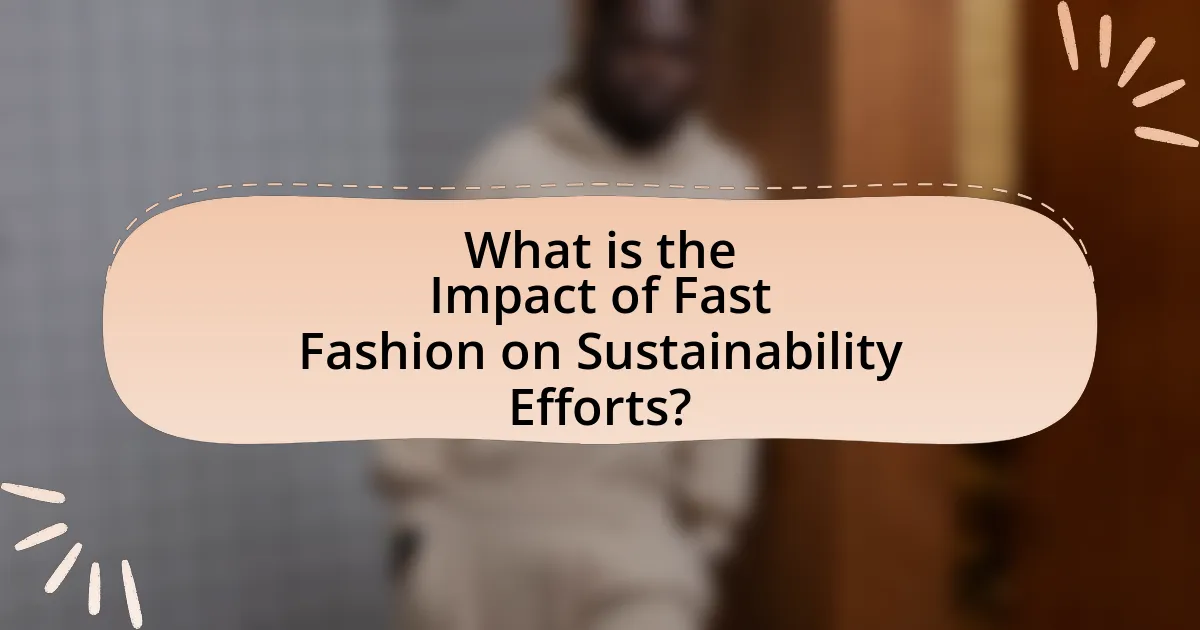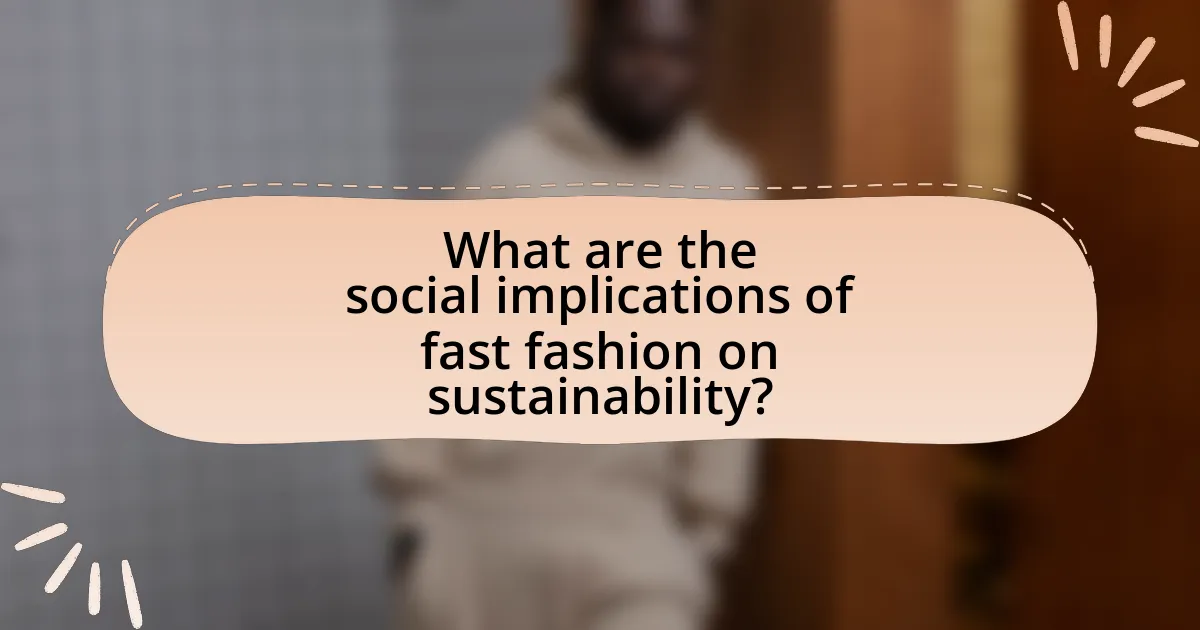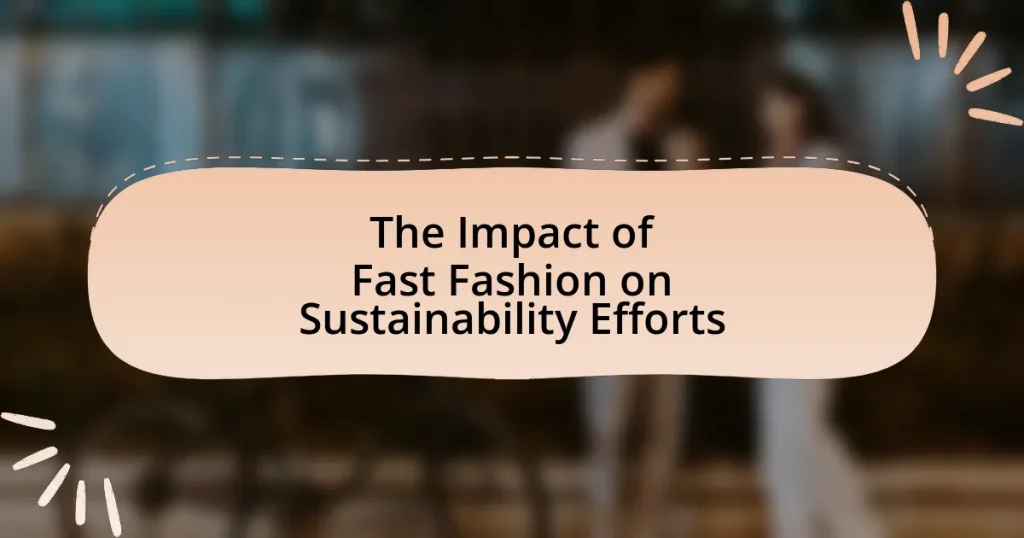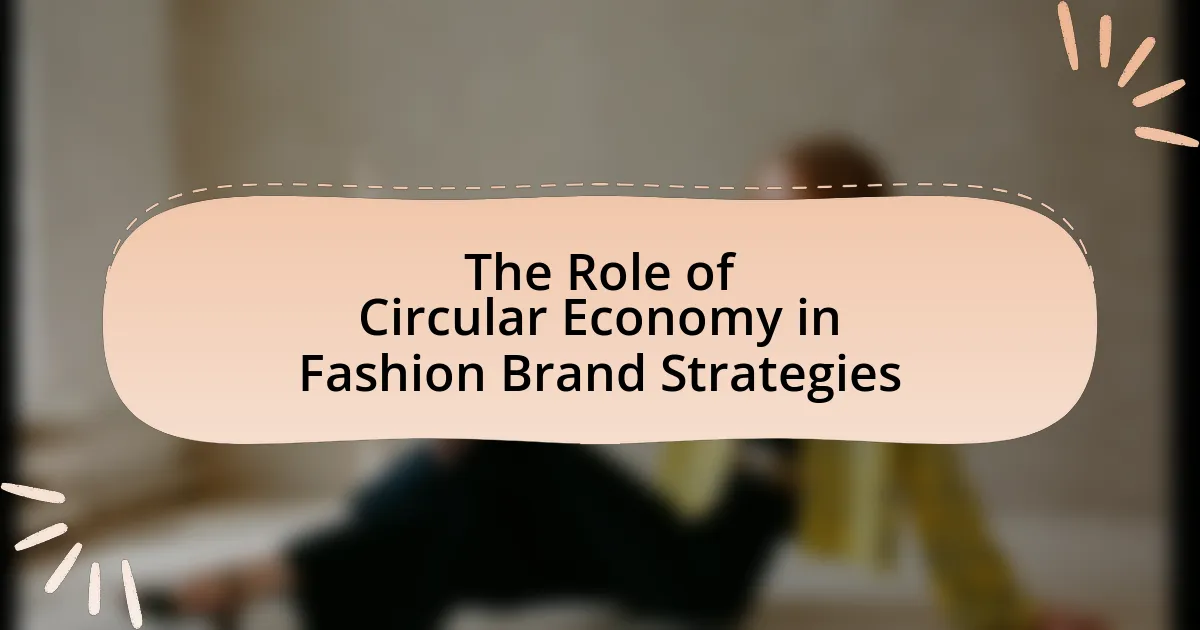The article examines the significant impact of fast fashion on sustainability efforts, highlighting its role in promoting overconsumption and waste. Fast fashion contributes to environmental degradation through excessive resource consumption, generating approximately 92 million tons of textile waste annually and accounting for about 10% of global greenhouse gas emissions. It also perpetuates exploitative labor practices, affecting workers’ rights and local economies. The discussion includes the environmental impacts of fast fashion production, the importance of sustainability in the fashion industry, and the role of consumer behavior in promoting sustainable practices. Additionally, it outlines initiatives and regulations aimed at counteracting the negative effects of fast fashion and emphasizes practical steps individuals can take to support sustainability in fashion.

What is the Impact of Fast Fashion on Sustainability Efforts?
Fast fashion significantly undermines sustainability efforts by promoting a culture of overconsumption and waste. The fast fashion industry produces approximately 92 million tons of textile waste annually, contributing to environmental degradation and resource depletion. Additionally, the rapid production cycles lead to increased carbon emissions, with the fashion sector responsible for about 10% of global greenhouse gas emissions. This unsustainable model not only strains natural resources but also perpetuates exploitative labor practices, further complicating efforts to achieve sustainable development goals.
How does fast fashion contribute to environmental degradation?
Fast fashion contributes to environmental degradation primarily through excessive resource consumption and waste generation. The industry relies on the rapid production of cheap clothing, which leads to the depletion of natural resources such as water and fossil fuels. For instance, producing a single cotton t-shirt requires approximately 2,700 liters of water, highlighting the significant water usage associated with fast fashion. Additionally, fast fashion generates substantial textile waste; around 92 million tons of textile waste are produced globally each year, with a large portion ending up in landfills. This waste not only occupies land but also contributes to soil and water pollution as synthetic fibers break down into microplastics. Furthermore, the fast fashion supply chain often involves harmful chemical processes that release pollutants into the environment, exacerbating air and water quality issues.
What are the specific environmental impacts of fast fashion production?
Fast fashion production has significant environmental impacts, including high water consumption, pollution, and waste generation. The fashion industry is responsible for using approximately 93 billion cubic meters of water annually, which contributes to water scarcity in many regions. Additionally, the production process releases toxic chemicals into waterways, with an estimated 20% of global wastewater coming from textile dyeing and treatment. Fast fashion also generates substantial textile waste, with around 92 million tons discarded each year, leading to increased landfill use and greenhouse gas emissions. These factors collectively highlight the detrimental effects of fast fashion on the environment.
How does fast fashion affect waste generation and landfill issues?
Fast fashion significantly increases waste generation and exacerbates landfill issues by promoting a culture of disposable clothing. The industry produces approximately 92 million tons of textile waste annually, with a large portion ending up in landfills. This is largely due to the rapid production cycles and low-cost garments that encourage consumers to discard items after only a few wears. Furthermore, synthetic fibers, which comprise a substantial part of fast fashion, take hundreds of years to decompose, contributing to long-term landfill problems. The Ellen MacArthur Foundation reports that if current trends continue, the fashion industry could account for more than a quarter of the global carbon budget by 2030, highlighting the urgent need for sustainable practices to mitigate waste generation and landfill impacts.
Why is sustainability important in the fashion industry?
Sustainability is important in the fashion industry because it addresses the environmental and social impacts of clothing production and consumption. The fashion industry is one of the largest polluters globally, contributing to significant waste, water usage, and carbon emissions. For instance, the Ellen MacArthur Foundation reports that the fashion industry is responsible for 10% of global carbon emissions and is the second-largest consumer of water worldwide. By prioritizing sustainability, the industry can reduce its ecological footprint, promote ethical labor practices, and encourage responsible consumer behavior, ultimately leading to a more sustainable future.
What are the key principles of sustainability in fashion?
The key principles of sustainability in fashion include ethical sourcing, resource efficiency, waste reduction, and social responsibility. Ethical sourcing ensures that materials are obtained from suppliers who adhere to fair labor practices and environmental standards. Resource efficiency focuses on minimizing the use of water, energy, and raw materials throughout the production process. Waste reduction emphasizes the importance of recycling and upcycling materials to decrease landfill contributions. Social responsibility involves ensuring fair wages and safe working conditions for all workers in the supply chain. These principles collectively aim to create a more sustainable fashion industry that mitigates the negative impacts of fast fashion.
How does consumer behavior influence sustainability efforts?
Consumer behavior significantly influences sustainability efforts by driving demand for eco-friendly products and practices. When consumers prioritize sustainable options, brands are compelled to adopt environmentally responsible practices to meet this demand. For instance, a 2021 survey by McKinsey & Company found that 67% of consumers consider sustainability when making purchasing decisions, leading companies to invest in sustainable materials and ethical production methods. This shift in consumer preferences not only encourages brands to innovate but also fosters a market environment where sustainability becomes a competitive advantage, ultimately contributing to broader environmental goals.

What are the social implications of fast fashion on sustainability?
Fast fashion significantly undermines sustainability by promoting a culture of overconsumption and waste. This industry encourages consumers to purchase clothing at an accelerated rate, leading to increased textile waste; in 2018, the United States alone discarded approximately 17 million tons of textile waste, much of which is attributed to fast fashion. Additionally, fast fashion often relies on exploitative labor practices in developing countries, where workers face poor working conditions and low wages, further exacerbating social inequalities. The environmental degradation caused by the production processes, including water pollution and high carbon emissions, also has social repercussions, as communities bear the brunt of these negative impacts. Thus, the social implications of fast fashion on sustainability are profound, affecting both human rights and environmental health.
How does fast fashion affect labor practices and workers’ rights?
Fast fashion negatively impacts labor practices and workers’ rights by promoting exploitative working conditions and inadequate wages. Workers in fast fashion supply chains often face long hours, unsafe environments, and minimal pay, with many earning less than the living wage. For instance, a report by the Clean Clothes Campaign highlights that garment workers in countries like Bangladesh earn as little as $95 per month, far below the estimated living wage of $315. Additionally, the fast-paced production demands lead to labor violations, including forced overtime and lack of union representation, undermining workers’ rights to fair treatment and safe working conditions.
What are the working conditions in fast fashion factories?
Working conditions in fast fashion factories are often characterized by low wages, long hours, and unsafe environments. Workers typically face excessive overtime, sometimes exceeding 60 hours per week, with minimal breaks. Reports indicate that many factories lack proper ventilation, sanitation, and safety measures, leading to health risks such as respiratory issues and injuries. A study by the Clean Clothes Campaign highlights that workers in countries like Bangladesh and Cambodia earn as little as $3 per day, far below the living wage. Additionally, labor rights violations, including harassment and lack of job security, are prevalent, further exacerbating the exploitation of workers in the fast fashion industry.
How does fast fashion impact local communities and economies?
Fast fashion negatively impacts local communities and economies by undermining local businesses and exploiting labor. The rapid production cycles and low prices of fast fashion brands often lead to a decline in sales for local retailers, as consumers gravitate towards cheaper, mass-produced clothing. This shift can result in job losses and reduced economic activity within communities. Furthermore, fast fashion companies frequently rely on low-wage labor in developing countries, where workers face poor working conditions and limited rights, exacerbating economic inequality. According to a report by the International Labour Organization, the garment industry employs over 60 million people globally, many of whom work in unsafe environments for minimal pay, highlighting the detrimental effects on local economies and communities.
What role do consumers play in promoting sustainability in fashion?
Consumers play a crucial role in promoting sustainability in fashion by influencing brands through their purchasing choices and preferences. When consumers prioritize sustainable products, they drive demand for eco-friendly materials and ethical production practices. For instance, a 2021 survey by McKinsey & Company found that 67% of consumers consider sustainability when making a purchase, indicating a significant shift towards environmentally conscious buying behavior. This consumer pressure encourages brands to adopt sustainable practices, such as reducing waste and improving supply chain transparency, ultimately contributing to a more sustainable fashion industry.
How can consumers make more sustainable fashion choices?
Consumers can make more sustainable fashion choices by prioritizing brands that use eco-friendly materials and ethical production practices. Research indicates that the fashion industry is responsible for 10% of global carbon emissions, highlighting the importance of conscious consumerism. By selecting clothing made from organic cotton, recycled materials, or sustainable fabrics like Tencel, consumers can reduce their environmental impact. Additionally, supporting brands that adhere to fair labor practices ensures that workers are treated ethically, further promoting sustainability. Engaging in second-hand shopping and clothing swaps also extends the lifecycle of garments, minimizing waste and resource consumption.
What are the benefits of supporting sustainable fashion brands?
Supporting sustainable fashion brands reduces environmental impact, promotes ethical labor practices, and encourages economic sustainability. By choosing sustainable brands, consumers help decrease the fashion industry’s carbon footprint, which is responsible for approximately 10% of global greenhouse gas emissions. Additionally, these brands often prioritize fair wages and safe working conditions, contributing to social equity. Supporting sustainable fashion also stimulates local economies, as many sustainable brands focus on local production and sourcing, thereby fostering community development and resilience.

What initiatives are being taken to counteract the impact of fast fashion?
Various initiatives are being implemented to counteract the impact of fast fashion, including sustainable fashion movements, regulatory measures, and consumer awareness campaigns. Sustainable fashion movements promote the use of eco-friendly materials and ethical production practices, with brands like Patagonia and Stella McCartney leading the way. Regulatory measures, such as the European Union’s proposed legislation to enforce circular economy principles, aim to hold brands accountable for their environmental impact. Additionally, consumer awareness campaigns, like Fashion Revolution’s “Who Made My Clothes?” initiative, encourage shoppers to consider the origins of their clothing and support ethical brands. These initiatives collectively aim to reduce waste, promote sustainability, and foster responsible consumer behavior in the fashion industry.
How are brands adapting to promote sustainability?
Brands are adapting to promote sustainability by implementing eco-friendly practices in their production processes and supply chains. For instance, many companies are shifting towards the use of sustainable materials, such as organic cotton and recycled polyester, which significantly reduce environmental impact. According to a report by McKinsey & Company, 67% of consumers consider sustainability when making a purchase, prompting brands to adopt transparent sourcing and ethical labor practices. Additionally, brands are increasingly investing in circular economy initiatives, such as take-back programs and recycling schemes, to minimize waste and extend the lifecycle of their products. This shift not only aligns with consumer demand but also addresses the pressing environmental challenges posed by fast fashion.
What are some examples of sustainable practices adopted by fashion brands?
Fashion brands are increasingly adopting sustainable practices such as using organic materials, implementing recycling programs, and reducing water consumption. For instance, brands like Stella McCartney utilize organic cotton and recycled polyester to minimize environmental impact. Additionally, H&M has launched a garment collecting initiative, allowing customers to recycle old clothes, which promotes circular fashion. Furthermore, brands like Patagonia focus on reducing water usage in production processes, with initiatives that have reportedly cut water consumption by 20% in certain lines. These practices demonstrate a commitment to sustainability in the fashion industry, addressing the environmental challenges posed by fast fashion.
How effective are these initiatives in reducing environmental impact?
These initiatives are moderately effective in reducing environmental impact. For instance, a study by the Ellen MacArthur Foundation found that implementing circular economy practices in the fashion industry could reduce greenhouse gas emissions by 44% by 2030. Additionally, brands adopting sustainable materials and production methods have shown a decrease in water usage and pollution levels. However, the overall effectiveness is often limited by the scale of implementation and consumer behavior, as many initiatives are not universally adopted across the industry.
What policies and regulations are influencing sustainability in fashion?
Policies and regulations influencing sustainability in fashion include the European Union’s Green Deal, which aims to make the fashion industry more sustainable by promoting circular economy practices and reducing waste. Additionally, the Fashion Act in New York mandates transparency in supply chains, requiring brands to disclose their environmental impact and labor practices. These regulations are designed to hold companies accountable for their sustainability efforts, as evidenced by the EU’s target to reduce greenhouse gas emissions by at least 55% by 2030 compared to 1990 levels. Furthermore, various countries are implementing extended producer responsibility (EPR) laws, compelling brands to take responsibility for the entire lifecycle of their products, thereby encouraging sustainable practices.
How do government regulations affect fast fashion practices?
Government regulations significantly influence fast fashion practices by imposing standards that promote sustainability and ethical labor. For instance, regulations such as the European Union’s Waste Framework Directive require companies to manage textile waste responsibly, pushing fast fashion brands to adopt recycling and circular economy practices. Additionally, labor laws in various countries mandate fair wages and safe working conditions, compelling fast fashion retailers to improve their supply chain transparency. These regulations aim to mitigate the environmental impact of fast fashion, which is responsible for 10% of global carbon emissions, according to the United Nations. Thus, government regulations serve as a critical mechanism to drive the fast fashion industry towards more sustainable practices.
What role do international agreements play in promoting sustainable fashion?
International agreements play a crucial role in promoting sustainable fashion by establishing frameworks that encourage environmentally friendly practices and ethical labor standards across the global textile industry. These agreements, such as the Paris Agreement and the United Nations Sustainable Development Goals, set binding targets for reducing carbon emissions and promoting sustainable resource management, which directly influence fashion brands to adopt more sustainable practices. For instance, the Fashion Pact, signed by major fashion companies, commits signatories to specific sustainability goals, including reducing greenhouse gas emissions and promoting biodiversity. This collective commitment fosters accountability and encourages innovation in sustainable materials and production methods, ultimately driving the industry towards a more sustainable future.
What practical steps can individuals take to support sustainability in fashion?
Individuals can support sustainability in fashion by choosing to buy second-hand clothing, which reduces waste and the demand for new production. Research indicates that the fashion industry is responsible for 10% of global carbon emissions, and purchasing used items can significantly lower this impact. Additionally, individuals can opt for sustainable brands that prioritize eco-friendly materials and ethical labor practices, as these companies often have lower environmental footprints. Engaging in clothing swaps or renting garments for special occasions also minimizes consumption and promotes a circular economy. Finally, individuals can educate themselves and others about the environmental impacts of fast fashion, fostering a community that values sustainable practices.
How can consumers reduce their fashion footprint effectively?
Consumers can effectively reduce their fashion footprint by opting for sustainable clothing choices, such as purchasing from eco-friendly brands, buying second-hand items, and prioritizing quality over quantity. Research indicates that the fashion industry is responsible for 10% of global carbon emissions, highlighting the importance of conscious consumerism. By choosing brands that utilize sustainable materials and ethical production practices, consumers can significantly lower their environmental impact. Additionally, buying second-hand clothing extends the lifecycle of garments, reducing waste and resource consumption associated with new production. Prioritizing quality ensures that clothing lasts longer, further minimizing the need for frequent replacements and the associated environmental costs.
What are some tips for choosing sustainable fashion options?
To choose sustainable fashion options, prioritize brands that use eco-friendly materials, such as organic cotton or recycled fabrics. These materials reduce environmental impact by minimizing water usage and chemical pollution. Additionally, consider brands that practice ethical labor standards, ensuring fair wages and safe working conditions for workers. Researching a brand’s supply chain transparency can provide insights into their sustainability practices. Supporting second-hand clothing stores or clothing swaps also promotes sustainability by extending the lifecycle of garments and reducing waste. According to the Ellen MacArthur Foundation, extending the life of clothing by just nine months can reduce carbon, water, and waste footprints by 20-30%.




